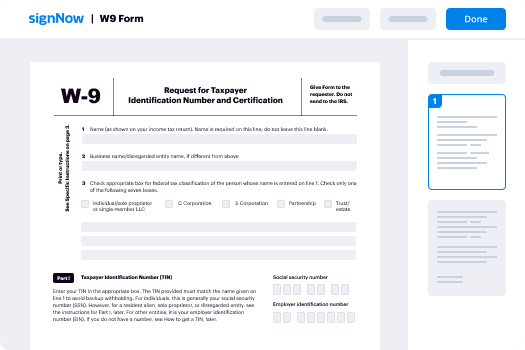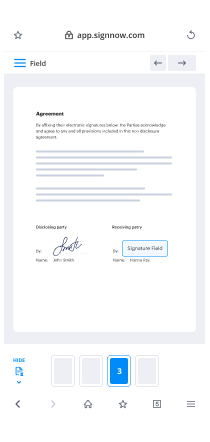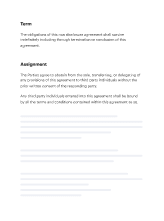Use Kiosk Mode, Add Text Tags and eSign
Get the powerful eSignature features you need from the company you trust
Choose the pro service created for pros
Whether you’re presenting eSignature to one department or throughout your entire organization, the process will be smooth sailing. Get up and running quickly with airSlate SignNow.
Configure eSignature API with ease
airSlate SignNow is compatible the applications, services, and gadgets you currently use. Easily embed it right into your existing systems and you’ll be effective instantly.
Collaborate better together
Increase the efficiency and productivity of your eSignature workflows by providing your teammates the ability to share documents and templates. Create and manage teams in airSlate SignNow.
Use kiosk mode add text tags and eSign, within a few minutes
Go beyond eSignatures and use kiosk mode add text tags and eSign. Use airSlate SignNow to negotiate agreements, gather signatures and payments, and automate your document workflow.
Cut the closing time
Eliminate paper with airSlate SignNow and reduce your document turnaround time to minutes. Reuse smart, fillable form templates and deliver them for signing in just a couple of minutes.
Maintain important information safe
Manage legally-binding eSignatures with airSlate SignNow. Run your organization from any location in the world on nearly any device while maintaining top-level protection and compliance.
See airSlate SignNow eSignatures in action
airSlate SignNow solutions for better efficiency
Keep contracts protected
Enhance your document security and keep contracts safe from unauthorized access with dual-factor authentication options. Ask your recipients to prove their identity before opening a contract to use kiosk mode add text tags and eSign.
Stay mobile while eSigning
Install the airSlate SignNow app on your iOS or Android device and close deals from anywhere, 24/7. Work with forms and contracts even offline and use kiosk mode add text tags and eSign later when your internet connection is restored.
Integrate eSignatures into your business apps
Incorporate airSlate SignNow into your business applications to quickly use kiosk mode add text tags and eSign without switching between windows and tabs. Benefit from airSlate SignNow integrations to save time and effort while eSigning forms in just a few clicks.
Generate fillable forms with smart fields
Update any document with fillable fields, make them required or optional, or add conditions for them to appear. Make sure signers complete your form correctly by assigning roles to fields.
Close deals and get paid promptly
Collect documents from clients and partners in minutes instead of weeks. Ask your signers to use kiosk mode add text tags and eSign and include a charge request field to your sample to automatically collect payments during the contract signing.
Collect signatures
24x
faster
Reduce costs by
$30
per document
Save up to
40h
per employee / month
Our user reviews speak for themselves






be ready to get more
Why choose airSlate SignNow
-
Free 7-day trial. Choose the plan you need and try it risk-free.
-
Honest pricing for full-featured plans. airSlate SignNow offers subscription plans with no overages or hidden fees at renewal.
-
Enterprise-grade security. airSlate SignNow helps you comply with global security standards.

Your step-by-step guide — use kiosk mode add text tags and eSign
Use Kiosk Mode, Add text tags and eSign. Get highest value from the most respected and secure eSignature platform. Improve your digital transactions using airSlate SignNow. Optimize workflows for everything from simple staff documents to complex contracts and marketing templates.
Understand how to Use Kiosk Mode, Add text tags and eSign:
- Upload multiple documents from your computer or cloud storage.
- Drag & drop smart fillable fields (signature, text, date/time).
- Alter the fields sizing, by tapping it and choosing Adjust Size.
- Insert dropdowns and checkboxes, and radio button groups.
- Add signers and request additional materials.
- Use Kiosk Mode, Add text tags and eSign.
- Add the formula the place you need the field to generate.
- Use comments and annotations for the users anywhere on the page.
- Save all changes by clicking on DONE.
Link users from outside and inside your business to electronically work on essential documents and Use Kiosk Mode, Add text tags and eSign anytime and on any system using airSlate SignNow. You may monitor every activity carried out to your samples, receive alerts an audit report. Stay focused on your business and consumer relationships while understanding that your data is precise and secure.
How it works
Access the cloud from any device and upload a file
Edit & eSign it remotely
Forward the executed form to your recipient
airSlate SignNow features that users love
See exceptional results Use Kiosk Mode, Add text tags and eSign
be ready to get more
Get legally-binding signatures now!
FAQs
-
I like writing poems. Which is the best website where I can write poems on my own blog?
I have been into writing from last couple of years. I tried creating a blog of my own, using right keywords and meta tags also, but didn’t see a lot of traffic coming in, except for a few friends and family (since I am not into digital marketing and all).Then I thought, why not try already available writing platforms. I tried a few I am giving you the list along with my experience of using them.PoemHunter.com : The website is an awesome place for sharing your work. There are lots of new-age writer. They also give you feedback. Although, through the interactions with other members, I felt th... -
How can boson share a quantum state? Is the Pauli exclusion principle applicable here?
The Pauli Exclusion principle can be derived rather simply by considering a two particle state, so I’ll do it here, and hopefully that will answer your question.We consider a system comprised of two electrons, denoted 1 and 2, and we package their states into a state like so: [math]| 1,2 \rangle[/math].If electron 1 is in a state [math]\phi[/math], and electron 2 is in a state [math]\psi[/math], we can write this as:[math]\displaystyle |1,2 \rangle = |\phi(x_1) \rangle |\psi(x_2) \rangle \tag*{}[/math]For example.We now consider an operator called the “particle exchange operator”, [math]\hat{P}[/math].Quite simply, this operator swaps the two particles around — electron two now occupies electron 1’s original state, and vice versa.[math]\displaystyle \hat{P} |1,2\rangle = |2,1\rangle \tag*{}[/math]The trick is to note that electrons are identical. Therefore our system should not behave any differently if electrons are switched. The dynamics of a quantum system are determined by the absolute magnitude [math]\langle \psi |\psi \rangle[/math], so the only thing that [math]P[/math] can do is add a complex phase shift (since phase shifts automatically cancel in the magnitude operation, and hence adding a shift does not affect the dynamics).[math]\displaystyle \hat{P} |1,2 \rangle = |2,1 \rangle = e^{i \theta} |1,2 \rangle \tag*{}[/math]We can work out exactly what [math]\theta[/math] is by applying [math]\hat{P}[/math] to the [math]|2,1\rangle[/math] state:[math]\displaystyle \hat{P} |2,1 \rangle = |1,2 \rangle = \hat{P}^2 |1,2\rangle\tag*{}[/math]But we know that all [math]\hat{P}[/math] does is add a complex phase [math]e^{i \theta}.[/math]Therefore, [math]\hat{P}^2 |1,2\rangle = e^{2 i \theta} |1,2 \rangle = |1,2\rangle[/math]Therefore:[math]\displaystyle e^{2 i \theta} = 1 \quad \rightarrow \quad e^{i \theta} = \pm 1 \tag*{}[/math]That was a bit of a deluge of mathematics, so I will quickly summarise what I’ve shown so far:If you swap two identical particles around in a quantum system, you either leave the wavefunction unchanged, or you add a minus sign.Both of these systems (as expected) produce the same dynamics when squared, as the minus sign cancels out.We call the particles which use +1 under particle exchange bosons, and particles which have -1 fermions.In other words:[math]\displaystyle \hat{P} |1,2\rangle = \begin{cases} |1,2\rangle & \text{for bosons} \\ -|1,2\rangle &\text{for fermions} \end{cases} \tag*{}[/math]You may have heard the definition that fermions have half-integer spin and bosons have integer spin. This is an equivalent definition, but is a) much more complex (requires the relativistic spin-statistics theorem) and b) historically came after this definition.OK. What does this have to do with Pauli Exclusion principle?Well, the problem is is that this exchange sign limits what states we can construct.Let’s try to write out explicitly a state for [math]|1,2\rangle[/math]Let’s use our original expansion in terms of [math]\psi[/math] and [math]\phi[/math]:[math]\displaystyle |1,2 \rangle = |\phi(x_1) \rangle |\psi(x_2) \rangle \tag*{}[/math]Now — let’s use [math]\hat{P}[/math] on this system.[math]\displaystyle \hat{P}|1,2 \rangle = |\phi(x_2) \rangle |\psi(x_1) \rangle \tag*{}[/math]But….We require that for a boson, [math]\hat{P} |1,2 \rangle = |1,2\rangle[/math]But…that is only true if [math]\phi = \psi[/math]! That’s not true in general….And for a fermion, we need a minus sign, which we don’t have any which way we look at it.What is going on?The requirements that particles are identical is limiting how we can construct our quantum systems!We need to think of a new way of writing them down.As a random guess — let’s try writing a system as:[math]\displaystyle |1,2\rangle = \left( |\phi(x_1), \psi(x_2)\rangle + |\psi(x_1), \phi(x_2) \rangle \right) \tag*{}[/math]If we use our exchange operator on this, then we get:[math]\displaystyle \hat{P}|1,2\rangle = \left( |\phi(x_2), \psi(x_1)\rangle + |\psi(x_2), \phi(x_1) \rangle \right) \tag*{}[/math]Which is…just [math]|1,2\rangle[/math] with the two addition terms switched around!We have found a way to write a boson’s quantum state which obeys the exchange symmetry!If we try this with a minus sign, we find that:[math]\displaystyle \hat{P} \left( |\phi(x_1), \psi(x_2)\rangle - |\psi(x_1), \phi(x_2) \rangle \right) = \left( |\phi(x_2), \psi(x_1)\rangle - |\psi(x_2), \phi(x_1) \rangle\right) \tag*{}[/math]This is just minus the original state — this is a valid way to write a fermions state in a two particle system!OK, we can now summarise:For a system of two particles, in states [math]\psi[/math] and [math]\phi[/math] respectively, the only ways to write them which obeys exchange symmetry is as follows:[math]\displaystyle |1,2\rangle = \begin{cases} |\phi(x_1),\phi(x_2)\rangle &\text{if boson, and } \phi = \psi \\ \frac{1}{\sqrt{2}} \left(|\phi(x_1),\psi(x_2) \rangle + |\phi(x_2),\psi(x_1) \rangle \right) & \text{if boson and} \phi \neq \psi \\ \frac{1}{\sqrt{2}} \left(|\phi(x_1),\psi(x_2) \rangle - |\phi(x_2),\psi(x_1) \rangle \right) & \text{if fermion} \end{cases} \tag*{}[/math]Phew. The extra factors of [math]\frac{1}{\sqrt{2}}[/math] are just normalisation factors, so that [math]\langle 1,2|1,2\rangle = 1[/math].It’s not entirely obvious yet, but we’ve actually just proved the Pauli Exclusion principle.Let’s first consider a boson, with two particles initially in different states [math]\psi[/math] and [math]\phi[/math]. We then introduce some potential which pushes them into the same state.What happens? Well…nothing.We can perfectly well describe a bosonic state by [math]|1,2\rangle = |\phi(x_1),\phi(x_2)\rangle[/math]All’s well there — two bosons can occupy the same quantum state.But if we try this same trick with a fermionic state?Well, our state is:[math]\displaystyle |1,2\rangle = \frac{1}{\sqrt{2}} \left(|\phi(x_1),\psi(x_2) \rangle - |\phi(x_2),\psi(x_1) \rangle \right) \tag*{}[/math]If we then let [math]\phi \to \psi[/math] …[math]\displaystyle |1,2\rangle = \frac{1}{\sqrt{2}} \left(|\phi(x_1),\phi(x_2) \rangle - |\phi(x_2),\phi(x_1) \rangle \right) \tag*{}[/math]And when we force them into the exact same state — [math]x_1 = x_2[/math], we find….[math]\displaystyle |1,2\rangle = 0 \tag*{}[/math]Ah.That is problematic.Our quantum state vanished.That means there is zero probability of finding two identical fermions in the same quantum state.And that is the Pauli Exclusion Principle!The Pauli Exclusion Principle arises from:Identical particlesWhich have a sign change under particle exchangeAnd then simply calculating how this requirement affects what quantum states we can write.This means that, by definition, bosons are not affected by it — because bosons are defined as not having a sign change under particle exchange.Since they do not have this sign-change-requirement, bosons are not restricted in this way, and can happily occupy the same quantum state.Fermions on the other hand, simply due to the mathematics of particle exchange, are restricted.It’s a seemingly very odd result that just thinking about what happens when you swap two particles around fundamentally limits what you can do with those two particles.But if you follow the mathematics through carefully, it is entirely logical that this result follows.Weird, right? -
What are the most popular eSigning service?
Tools such as airSlate SignNow(website) and signNowSign(website) are gaining popularity for businesses because they provide quality solutions for electronic signature. In particular advantages such as these take them to a new level:Get documents eSigned anytime, anywhere, on any device while keeping the spotlight on your brandSecure your documents and each person's signature using military-grade, digital signature technologyProve your compliance and deflect legal disputes with the most comprehensive audit trails -
Is it possible to evaluate [math]\int_{0}^{\infty}\cos\left(x^2\right)\mathrm{d}x[/math] without using complex analysis?
Yes! And I bet I can do it in a way that most of you have never seen before. Also, most of the other answers here require that you know[math]\displaystyle{\int_{0}^{\infty} e^{-x^2} dx = \dfrac{\sqrt{\pi}}{2}}[/math]But the only requirement you need to know for this answer is[math]e^{ix} = \cos{x}+i\sin{x}[/math]Which I don't consider to be ‘complex analysis' in the slightest.(Oh, and you also need to know some integration and differentiation techniques, but nothing too complicated.)Now for the moment of truth…We introduce the (extraordinary!) function[math]\displaystyle{G(x)=\left\{\int_{0}^{x}e^{it^2}dt\right\}^2+i\int_{0}^{1}\dfrac{e^{ix^2(t^2+1)}}{t^2+1}dt}[/math]Now let's differentiate [math]G(x)[/math]. We have two integrals, and we differentiate them in different ways. The first is much easier since[math]\displaystyle{\dfrac{d}{dx}\int_{0}^{x}e^{it^2}=e^{ix^2}}[/math]And then we use the chain rule bec... -
How do I integrate [math]\exp \left(-x^2\right) \sin \left(x^2\right)[/math], with respect to [math]x[/math] from [math]0[/math] to [math]\infty[/math]?
How do I integrate: exp(-x²) sin(x²) , with x from 0 to infinity? In my modest advertising campaign to think and work generically I would go as far as paraphrasing the saying by Albert Einstein make it as simple as possible but not simpler intomake it as generic as possible but not too genericAs such, consider two, as is often fruitful, integrals as functions in two real variables [math]a[/math] and [math]b[/math] such that [math]a>0, b\geqslant 0[/math]:[math]\displaystyle C(a,b)=\int_0^{+\infty}e^{-ax^2}\cos bx^2\;dx \tag{1}[/math][math]\displaystyle S(a,b)=\int_0^{+\infty}e^{-ax^2}\sin bx^2\;dx \tag{2}[/math]which constitute a happy marriage of two, famous by now, integrals - that of Fresnel:[math]\displaystyle \int_0^{+\infty}\cos x^2\;dx=\int_0^{+\infty}\sin x^2\;dx = \dfrac{\sqrt{2\pi}}{4} \tag*{}[/math]and that of Euler-Poisson:[math]\displaystyle \int_0^{+\infty}e^{-x^2}\;dx = \dfrac{\sqrt{\pi}}{2} \tag*{}[/math](which we compute in this Quora answer).Take the first partial derivatives of [math]C(a,b)[/math] and [math]S(a,b)[/math] with respect to [math]b[/math] using the rule due to G. Leibniz:[math]\displaystyle \dfrac{\partial C(a,b)}{\partial b}=-\int_0^{+\infty}x^2e^{-ax^2}\sin bx^2\;dx \tag{3}[/math][math]\displaystyle \dfrac{\partial S(a,b)}{\partial b}=\int_0^{+\infty}x^2e^{-ax^2}\cos bx^2\;dx \tag{4}[/math]Integrating the R... -
What is a top 10 SEO strategy for better optimisation?
1. Knowing who is your Audience2. Relevant Content3. Keyword relevant Url structure 4. Keyword Relevant Titles5. Have keyword anchor text density below 5%6. Back-link from sites with high DA,PA,Trust,Citation,PR7. Adding Youtube videos on site8. STAY AWAY FROM LINK FARMS9. Utilizing LSI keywords 10. Doing PPC lol -
What is the integration of [math]\dfrac{1}{x}[/math]?
On the one hand, when we integrate [math]x, x^2, x^3, x^4[/math] and so on we get a nice, predictable pattern and on the other hand, when we integrate [math]x^{-2}, x^{-3}, x^{-4}[/math] and so on we also get a nice, predictable pattern.However, when we try to integrate [math]x^{-1}[/math] then we get … a hiccup in the pattern.What is going on here?It is understandable that even when people are told what the answer is they, nonetheless, walk away confused. My answer to this type of confusions - put on the boots and walk to the top - yourself, every inch of the way.Between the above two families of integrals there lies a discovery - of a new function by the Scott John Napi... -
How can I implement machine learning algorithms in a web application?
From your question I inferred you are talking about online/web-based applications. Obviously there are other applications, like standalone medical devices, etc. that have a different story. Assuming that, let's divide the problem into four components:1- You need a database. Your choice depends on different aspects but most important thing is size and speed of your data. For small sized problems a regular RDBMS will do the job.2- You need a component to build dynamic HTML pages. A typical web programming language like PHP will do that job. Your dynamics HTML component manages communication w...
What active users are saying — use kiosk mode add text tags and eSign
Related searches to Use Kiosk Mode, Add text tags and eSign
electronic signature app
electronic document signing
sign now
digital signature applications
signno
electronic consent form app
signnow in person signing
Frequently asked questions
How do you generate a document and apply an electronic signature to it?
The easiest way is to use airSlate SignNow. The platform allows you to upload a document and apply your eSignature to it in just a couple of clicks. Select the My Signature element from the left-hand toolbar and drag and drop where you want/need it. Confirm its placement by clicking OK. Once it’s placed, create a unique eSignature by drawing one, typing your full name, or uploading a picture of your handwritten one. You can also send a sample for signing to recipients and have the ability to apply more than just your legally-binding electronic signature.
How do I sign one page in a PDF and send it back?
airSlate SignNow gives you the ability to insert your signature on the pages that require it. You can sign one PDF page, each page, or multiple pages, using the My Signature element. Place your signature wherever and however many times you need to. After you’ve created your signature once, It’s not necessary to generate a new one each time. Your eSignature is automatically saved, meaning that you can reuse it in just one click. Once you’ve signed the document, simply email it back to whoever sent it to you.
How can I get others to sign a PDF file?
Create a airSlate SignNow account and collect signatures from your partners, clients, and team members without losing time. Upload a PDF and grab a Signature Field from the left-side toolbar. Drop it where you need someone to sign the document. Add as many of them as you need. Then, assign Roles to each field, customize a signing order, and click the Invite To Sign button. Add your recipients’ email addresses, and set notifications. Once they complete and sign it, you’ll get a confirmation message and will have immediate access to the executed document in your account.
Get more for use kiosk mode add text tags and eSign
The ins and outs of eSignature

How to sign a PDF on Mac
See how it’s easy to sign PDF documents on Mac. Use our tips & tricks and step-by-step instruction to create your unique eSignature and sign with airSlate SignNow.

Need to sign a PDF: what to start with?
Find out how to electronically sign a PDF document without the need to print or scan it. Learn how to save your time and money with an eSignature solution.

What file types can be uploaded?
airSlate SignNow supports dozens of popular file formats and enables you to close deals and certify important documents even while on the go.
Find out other use kiosk mode add text tags and eSign
- Learn how to insert a digital signature in Word with AI
- Learn how to insert a digital signature in Word with ...
- Learn how to insert a digital signature into a Word ...
- Learn how to insert a digital signature into a Word ...
- Learn how to insert a signature in a Word document with ...
- Learn how to insert a signature in a Word document with ...
- Learn how to insert a signature in Excel with AI
- Learn how to insert a signature in Excel with ...
- Learn how to insert a signature in Excel on a Mac with ...
- Learn how to insert a signature in Excel on a Mac with ...
- Learn how to insert a signature in Google Doc with AI
- Learn how to insert a signature in Google Doc with ...
- Learn how to insert a signature in Google Docs with AI
- Learn how to insert a signature in Google Docs with ...
- Learn how to insert a signature in Google Sheets with ...
- Learn how to insert a signature in Google Sheets with ...
- Learn how to insert a signature in pages with AI
- Learn how to insert a signature in pages with ...
- Learn how to insert a signature in PDF with AI
- Learn how to insert a signature in PDF with Artificial ...












































